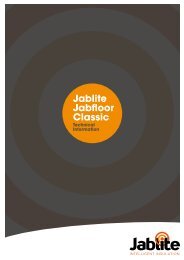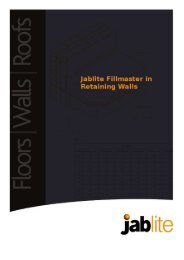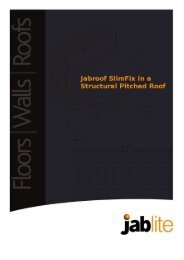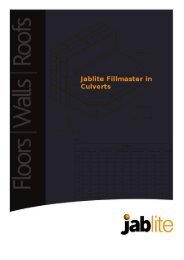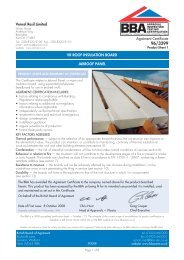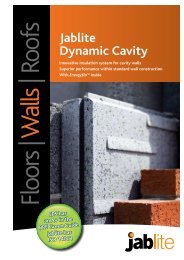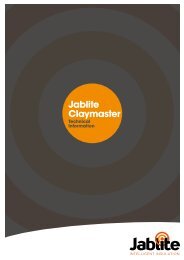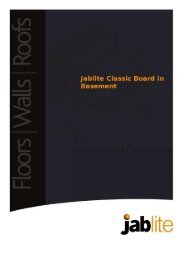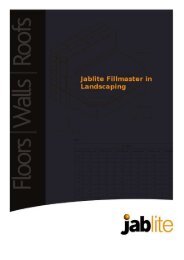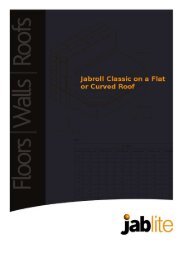underfloor heating UFH-C - Jablite
underfloor heating UFH-C - Jablite
underfloor heating UFH-C - Jablite
- No tags were found...
Create successful ePaper yourself
Turn your PDF publications into a flip-book with our unique Google optimized e-Paper software.
APPLICATION:Floor insulation – <strong>underfloor</strong> <strong>heating</strong>Products: <strong>Jablite</strong> <strong>UFH</strong>-L<strong>Jablite</strong> <strong>UFH</strong>-C<strong>Jablite</strong> <strong>UFH</strong>-MProduct description Floor finish Page77Floor Insulation<strong>Jablite</strong> <strong>UFH</strong>-L – laminated board Screed 78<strong>Jablite</strong> <strong>UFH</strong>-C – castellated board Screed 82<strong>Jablite</strong> <strong>UFH</strong>-M – moulded board Timber 86Underfloor <strong>heating</strong> systems create invisible warmth by use of a series of pipes set in<strong>Jablite</strong> Expanded Polystyrene (EPS) panels under a screed or timber floor. Workingwith leading contractors, the company has developed three <strong>Jablite</strong> UnderfloorHeating panels for use with current <strong>underfloor</strong> <strong>heating</strong> systems and to meet thegrowing demand for <strong>underfloor</strong> <strong>heating</strong> in new build commercial and domesticapplications. <strong>Jablite</strong> <strong>UFH</strong>-L, <strong>Jablite</strong> <strong>UFH</strong>-C and <strong>Jablite</strong> <strong>UFH</strong>-M are suitable for bothdomestic and commercial applications.Key benefits of <strong>underfloor</strong><strong>heating</strong> systems■ Clean interior design and maximumusable wall space■ Safer and cleaner than radiators as nodirect hot surfaces■ Dust and air movement is minimised■ Low maintenance systems■ Uniform heat distribution over thesurface area■ Hot and cold spots eliminatedEasy to handle<strong>Jablite</strong> <strong>UFH</strong> panels are manufactured fromexpanded polystyrene (EPS) which islightweight and easy to handle on site.Permanent<strong>Jablite</strong> <strong>UFH</strong> panels are rot-proof anddurable and will remain effective for thelife of the building. They also have theadvantage of being flood-proof.EnvironmentExpanded polystyrene has been awardedan A+ rating by the BRE’s Green Guide toSpecification.FireSolid ground floors are not required toprovide fire resistance. When properlyinstalled, <strong>Jablite</strong> <strong>UFH</strong> panels are fullyprotected by the screed or the chipboardand will have no adverse effect on the fireperformance of the floor. Euroclass E,flame-retardant additive material isavailable to order.U-valuesThe rate of heat loss through a groundfloor varies with its size and shape.The thickness of insulation required tomeet a given U-value will similarly dependon the size and shape of the floor.Approved Documents L1A , L1B, L2A andL2B guide you to BS EN ISO 13370 as themethod for determining floor U-valuesbased on the floor perimeter and floor areawhere: “P” is length of exposed perimeterin metres and “A” is floor area insquare metres.The measurement of both the floor areaand perimeter should be made on theinternal finished surface of the wallsenclosing the heated space; unheatedareas such as garages, porches and storagespaces need not be included. For buildingssuch as terraces or blocks of flatsand apartments, the measurementshould be taken over the total grossground-floor area.For technical information 0870 444 8769 technical@jablite.co.uk
82APPLICATION:Floor insulation – <strong>underfloor</strong> <strong>heating</strong> <strong>UFH</strong>-CProduct: <strong>Jablite</strong> <strong>UFH</strong>-C<strong>Jablite</strong> <strong>UFH</strong>-C is a castellated floor panelsuitable for use in domestic andcommercial solid floor applications with ascreed finish. The panels form a simple gridto enable the quickest possible pipe layingand a precise guide for minimum bendingradius. The castellated shape sets the pipesat exact centres and holds the pipe againstmovement when screeding the floor.Type<strong>Jablite</strong> <strong>UFH</strong>-C panels are supplied as EPS150 as defined in BS EN 13163 – Reactionto Fire Class E, containing a flameretardant additive.U-valuesTables 15.7 – 15.12 show the standardthickness of Jabfloor 70, 100 and 150required to supplement the 58mm thick<strong>Jablite</strong> <strong>UFH</strong>-C Panel to meet U-values of0.25, 0.22, 0.20, 0.18, 0.15, 0.10W/m 2 K.Where the <strong>Jablite</strong> <strong>UFH</strong>-C Panel achievesthe required U value on its own the text‘<strong>UFH</strong>-C’ has been placed in the table.These values are based on the followingk-values:Jabfloor 70Jabfloor 100Jabfloor 1500.038W/mK0.036W/mK0.035W/mKDimensionsBoard size overall: 1030 x 830mmThickness: 58mmBoard size cover: 1000 x 800mmThickness castellations: 25mmDiameter of castellations: 85mm
83Floor insulation – <strong>underfloor</strong> <strong>heating</strong> <strong>UFH</strong>-CTable 15.7 Table 15.8U-value: 0.25 W/m 2 KU-value: 0.22 W/m 2 KP/A Ratio Jabfloor 70 Jabfloor 100 Jabfloor 150P/A Ratio Jabfloor 70 Jabfloor 100 Jabfloor 1501.00 60 50 501.00 75 75 750.90 50 50 500.90 75 75 750.80 50 50 500.80 75 75 750.70 50 40 400.70 75 60 600.60 40 40 400.60 60 60 600.50 30 30 300.50 50 50 500.40 25 25 250.40 40 40 400.30 25 25 250.30 30 25 250.25 <strong>UFH</strong>-C <strong>UFH</strong>-C <strong>UFH</strong>-C0.25 25 25 250.20 <strong>UFH</strong>-C <strong>UFH</strong>-C <strong>UFH</strong>-C0.20 <strong>UFH</strong>-C <strong>UFH</strong>-C <strong>UFH</strong>-C0.15 <strong>UFH</strong>-C <strong>UFH</strong>-C <strong>UFH</strong>-C0.15 <strong>UFH</strong>-C <strong>UFH</strong>-C <strong>UFH</strong>-CFloor InsulationTable 15.9 Table 15.10U-value: 0.20 W/m 2 KU-value: 0.18 W/m 2 KP/A Ratio Jabfloor 70 Jabfloor 100 Jabfloor 150P/A Ratio Jabfloor 70 Jabfloor 100 Jabfloor 1501.00 100 100 1000.90 100 100 1000.80 100 100 1000.70 100 75 750.60 75 75 600.50 75 75 600.40 60 60 500.30 40 40 400.25 30 30 300.20 25 25 250.15 <strong>UFH</strong>-C <strong>UFH</strong>-C <strong>UFH</strong>-CTable 15.11 Table 15.12U-value: 0.15 W/m 2 KP/A Ratio Jabfloor 70 Jabfloor 100 Jabfloor 1501.00 150 150 1500.90 150 150 1500.80 150 150 1500.70 150 150 1500.60 150 150 1500.50 150 120 1200.40 120 120 1200.30 100 100 1000.25 100 100 1000.20 75 75 750.15 40 40 401.00 120 120 1000.90 120 100 1000.80 120 100 1000.70 100 100 1000.60 100 100 1000.50 100 100 1000.40 75 75 750.30 60 60 600.25 50 50 500.20 30 30 250.15 <strong>UFH</strong>-C <strong>UFH</strong>-C <strong>UFH</strong>-CU-value: 0.10 W/m 2 KP/A Ratio Jabfloor 70 Jabfloor 100 Jabfloor 1501.00 265 255 2450.90 265 250 2450.80 260 250 2400.70 255 245 2350.60 250 240 2300.50 245 230 2250.40 230 220 2150.30 215 200 2000.25 200 200 2000.20 200 200 2000.15 150 150 150Key: Standard thickness of Jabfloor to supplement <strong>UFH</strong>-C Panel <strong>UFH</strong>-C = panel onlyNon-Standard Thickness of Jabfloor to supplement <strong>UFH</strong>-C PanelU values based on 75mm screed over <strong>UFH</strong>-C & Jabfloor over a ground bearing slab. The above thicknesses can be reduced by supplementing the <strong>UFH</strong>-Cpanel with Jabfloor Premium. U values for other floor build-ups can be provided – please contact the technical deartment.For technical information 0870 444 8769 technical@jablite.co.uk
84APPLICATION:Floor insulation – <strong>underfloor</strong> <strong>heating</strong> <strong>UFH</strong>-CFigure 15.4Screed Finish<strong>Jablite</strong> <strong>UFH</strong>-CUnderfloor Heating pipesJabfloor edge stripDamp-proof membraneConcrete slab
85Floor insulation – <strong>underfloor</strong> <strong>heating</strong> <strong>UFH</strong>-CINSTALLATIONThe surface to receive the <strong>Jablite</strong> <strong>UFH</strong>-Cshould be level and even, providing a fullysupporting surface. A standard tampedconcrete finish is considered sufficient.Level discrepancies are common withsuspended beam and block and concreteplank floors, a levelling screed orcompound should be used to remove levelvariations. Dry sand is not recommendedas a levelling medium.Damp proof membraneA damp proof membrane must beprovided for ground bearing slabs, this canbe placed above or below the concreteslab. Damp proof membranes are notrequired over suspended concrete floors,however there may be a requirement fora protective barrier against Radon, othergases or ground contaminants.If a liquid damp proof membrane is usedthis will be applied to the concrete floorsurface. Care should be taken to ensure itis compatible with <strong>Jablite</strong> EPS and that itis completely dry before insulation is laid.<strong>Jablite</strong> <strong>UFH</strong>-C<strong>Jablite</strong> <strong>UFH</strong>-C should be laid over theprepared surface with the panel overlapjoints tightly interlocking. The pipes forthe <strong>underfloor</strong> <strong>heating</strong> system are thenplaced around the castellated upstandsas required.ScreedingThe screed is poured directly ontothe surface of the <strong>Jablite</strong> <strong>UFH</strong>-C.The recommendations of theappropriate parts of BS 8204 shouldalways be followed.Figure 15.5Damp-proof membrane below insulationSand/cement screeds should be at least65mm thick for domestic, 75mm nondomestic.A minimum 25mm screed coverover pipework should be maintained. Inorder to minimise cracking or curling, thescreed should be laid so that jointlessareas do not exceed 15m² and withthe ratio of length to width notexceeding 1.5:1.If these limits cannot be observed, theuse of a light-gauge galvanised metalreinforcement, placed centrally in thescreed, will help to distribute shrinkagecracks evenly.During screeding operations, the surfaceof the <strong>Jablite</strong> <strong>UFH</strong>-C should be protectedfrom impact damage or excessivetrafficking by the use of spreader boards.A 30mm thick perimeter edge strip ofinsulation should be provided for the depthof the screed to reduce cold bridging asrecommended in BRE Report 262.ReferencesBRE Report 262. Thermal insulation: avoiding risks – Third edition 2002.BS 8204 Screeds, bases and insitu floorings.BS 7916 Code of practice for selection and application of particle board, oriented strand board (OSB), cement bonded particle boardsand wood fibreboards for specific purposes.BS EN ISO 13370 Thermal performance of buildings – Heat transfer via the ground – Calculation methods.BS EN 13163 Thermal insulation products for buildings – factory made products of expanded polystyrene (EPS) – specification.21 35461. <strong>Jablite</strong> <strong>UFH</strong>-C2. Jabfloor edge strip3. Screed4. Underfloor Heating pipes5. Concrete slabFigure 15.6Damp-proof membrane below concrete slab21 35466. Damp-proof membrane1. <strong>Jablite</strong> <strong>UFH</strong>-C2. Jabfloor edge strip3. Screed4. Underfloor Heating pipes5. Concrete slab6. Damp-proof membraneFloor InsulationFor technical information 0870 444 8769 technical@jablite.co.uk
200<strong>Jablite</strong>Expanded Polystyrene (EPS) Technical Information<strong>Jablite</strong> EPS is a lightweight cellular plastic material suitable for a wide range of buildinginsulationapplications. It is an excellent insulating medium which exhibits consistentthermal performance over the range of temperatures normally encountered in buildings.The material is versatile, light in weight, clean and easy to handle,and provides a cost-effective means of including permanent insulation in floors, walls androofs to meet, and exceed, the standards laid down in the Building Regulations.Technical DescriptionComposition<strong>Jablite</strong> insulation products aremanufactured from EPS. The materialcomprises expandable beads ofpolystyrene pre-foamed and fusedtogether in a steam-heated mould underpressure. This produces a block of material,up to 7314mm long, which is then cut toand/or shape. After cutting to size, thematerial may be faced or laminated withother materials to suit its application.Alternatively, the beads may be mouldedinto a finished, shaped section whichrequires no further processing.Material TypeThe following types of material areavailable, as defined in BS EN 13163:EPS 70, EPS 100, EPS 150, EPS 200,EPS 250.In addition, each type is available as eitherEuroclass F, or Euroclass E containing aflame-retardant additive.Additional types are also available forspecific applications; for example, typeswith compressive-stress values, at 10%, of400 and 500kPa.Typical properties of <strong>Jablite</strong><strong>Jablite</strong> TypeMechanical PropertiesCompressive strength@ 10% compression (kPa)Compressive strength@ 1% nominal strain (kPa)EPS 70 EPS 100 EPS 150 EPS 200 EPS 25070 100 150 200 25020 45 70 90 100Bending strength (kPa) 115 150 200 250 350Moisture PropertiesWater vapour diffusionresistance factor µWater vapour permeabilityδ mg/(Pa.h.m)20-40 30-70 30-70 40-100 40-1000.018-0.036 0.010-0.024 0.010-0.024 0.007-0.018 0.007-0.018Vapour resistivity (MNs/gm) 145 200 238 238 238Thermal PropertiesThermal conductivity(W/mK, at 10ºC)0.038 0.036 0.035 0.034 0.034Thermal resistivity (mK/W) 26.32 27.78 28.57 29.41 29.41Shape and sizeAfter moulding, the ‘block’ material is cutto size, thickness and taper, if required,according to the intended end use; seeindividual product and application data.
201Technical Description(continued)TolerancesIn accordance with BS EN 13163tolerances on the cut dimensions aredefined as follows:Length: ± 3mm or ± 0.6% whichever isgreater (L1)Width: ± 3mm or ± 0.6% whichever isgreater (W1 )Thickness: ± 2mm (T1)Squareness: ± 5mm per 1000mm (S1)Alternative tolerances can be provided forspecific applications.Dimensional stabilityIn accordance with BS EN 13163 =DS(N)5 ± 0.5% under constant laboratoryconditions.Properties& Performance(Please refer to the table on the previouspage)Mechanical properties<strong>Jablite</strong> EPS has a high strength to weightratio.Tensile strengthRanges from 20-400kPa, according to typeand product.Compressive strengthRanges from 70-250kPa, according to typeand product; method of test, BS EN 826.Bending strengthRanges from 115-350kPa, according tograde and product; method of test BS4370:Part 1, method 4.Fire PropertiesIn common with all organic materials, EPSis combustible. However, provided it isspecified and installed correctly and inaccordance with the manufacturer’sinstructions and BS 6203, it will notpresent any undue fire hazard.The standard recommends that for allapplications, the material should beprotected by either a laminated facinglayer, or should be protected by being fullyenclosed by the form of construction.Euroclass E ‘flame-retardant’ additivematerial is available for most applications:this reduces the rate of flame spread butshould not be considered as offeringenhanced fire performance.CombustionEPS is ‘combustible’ as defined inBS 476:Part 4.Technical data <strong>Jablite</strong>DensityThe density range is 15-35kg/m³ for EPStypes shown below.Nominal DensitiesEPS 70 15kg/m³EPS 100EPS 150EPS 200EPS 25020kg/m³25kg/m³30kg/m³35kg/m³StandardsWhere relevant, <strong>Jablite</strong> products areproduced to the requirements of BS EN13163 'Thermal insulation products forbuildings – Factory made products ofexpanded polystyrene (EPS) –specification'.Vencel Resil Limited has been assessedand approved to BS EN ISO 9001:2000‘Quality systems; for quality assurance inproduction, installation and servicing’.Design loadRanges from 20-100kPa for 1% nominalstrain, according to type and product;method of test EN 826.Moisture PropertiesAlthough <strong>Jablite</strong> has significant resistanceto the passage of water vapour, it shouldnot be regarded as a damp-proofmembrane or vapour-control layer, andwill not provide a barrier against damppenetration.A suitable damp-proof membrane orvapour-control layer will be required inmost forms of construction: see individualproduct and application data.When burning, EPS behaves like otherhydrocarbons such as wood and paper.For Euroclass F material, the products ofuncontrolled combustion are carbonmonoxide, carbon dioxide, styrene, andwater vapour; the decomposing styrenewill give off a certain amount of denseblack soot. Euroclass E material also emitshydrogen bromide when burning.Ignition temperatureFlash ignition temperature is between 350and 490ºC depending on the applicationand the exact circumstances of use.Under certain circumstances the materialcan be readily ignited by a naked flamebut providing it is correctly installed, thisdoes not present any disadvantage in use.Calorific value40MJ/kg.Specific heat capacity1.13kJ/kgºC.Surface spread of flameUnfaced material, regardless of type,should not be exposed when installed inhabitable areas.For technical information 0870 444 8769 technical@jablite.co.uk
202<strong>Jablite</strong>Expanded Polystyrene (EPS) Technical InformationBiological PropertiesEPS will not sustain mould growth, andhas no nutrient value to insects or vermin.The material is non-biodegradable andcare should be taken to dispose of wasteand offcuts at a licensed waste site.Thermal PropertiesThermal movementCoefficient of linear expansion, 0.6 x10-6/ºC.The material is sufficiently resilient andflexible that no allowance need be madefor thermal expansion in the method ofinstallation.<strong>Jablite</strong> EPS is suitable for meeting, and inmany cases exceeding, the thermalinsulation requirements set out in theBuilding Regulations ApprovedDocuments:L1AConservation of fuel and power in newdwellings.L1BConservation of fuel and power in existingdwellings.L2AConservation of fuel and power in newbuildings other than dwellings.L2BConservation of fuel and power in existingbuildings other than dwellings.Reference can be made to individualproducts sections to obtain specific detailson meeting thermal values with <strong>Jablite</strong>products.Working temperature rangeEPS can be used within the temperaturerange -150ºC to +80ºC.<strong>Jablite</strong> EPS is unaffected by the normalrange of climatic temperatures and can besafely used in cold stores and similarapplications.During installation, and in service, contactwith hot-water pipes or other surfaceswhere the temperature is likely to exceed80ºC for continuous periods should beavoided.A minimum 12mm air gap should bemaintained between the insulation andhot-water pipes, or they should be lagged.In roofing applications, care should betaken that hot bitumen is not allowed to‘pool’ under the insulation duringinstallation since this can result in burningof the underside.Compatibility with othermaterialsEPS is soluble in aromatic, halogenatedsolvents and ketones; it should beprotected from contact with hydrocarbonsand strong solvents using a suitablemembrane.The material is unaffected by contact withsolvent-free bitumen providing that,where necessary, the precautions set outabove regarding temperature areobserved.EPS should not be permitted to come intocontact with PVC-sheathed electricalcables since this will lead to migration ofplasticiser from the PVC resulting inembrittlement of the cable sheath. Cablesshould be protected by the use of aphysical barrier, for example by beingenclosed in a conduit or by anair gap.Service LifeProviding it is correctly installed andprotected, <strong>Jablite</strong> will remain effective forthe life of the building.StorageStore <strong>Jablite</strong> boards under cover, protectedfrom high winds and out and out of directsunlight. Care should be taken in storagenot to bring the boards into contact withhighly flammable materials such as paint,solvent or petroleum products. Smokingshould be prohibited in the storage areaand the products must not be exposed toflame or other ignition source.
For more information about<strong>Jablite</strong> please contact us on:Tel: 0870 600 3666Email: sales@jablite.co.ukVisit: www.jablite.co.uk<strong>Jablite</strong> LimitedHead Office: Infinity House, Anderson Way, Belvedere, Kent DA17 6BG



